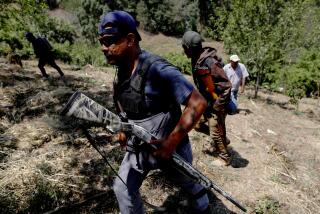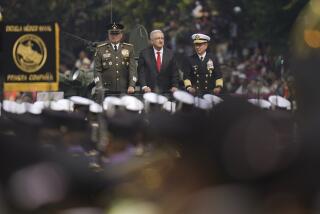Mexico still waiting for answers on Fast and Furious gun program
Reporting from Mexico City and Washington â Last fallâs slaying of Mario Gonzalez, the brother of a Mexican state prosecutor, shocked people on both sides of the border. Sensational news reports revealed that cartel hit men had tortured Gonzalez, and forced him to make a videotaped âconfessionâ that his high-powered sister was on the take.
But American authorities concealed one disturbing fact about the case from their Mexican counterparts: U.S. federal agents had allowed AK-47 assault rifles later found in the killersâ arsenal to be smuggled across the border under the notorious Fast and Furious gun-trafficking program.
U.S. officials also kept mum as other weapons linked to Fast and Furious turned up at dozens of additional Mexican crime scenes, with an unconfirmed toll of at least 150 people killed or wounded.
Months after the deadly lapses in the program were revealed in the U.S. media â prompting congressional hearings and the reassignment of the acting chief of the Bureau of Alcohol, Tobacco, Firearms and Explosives â top Mexican officials say American authorities have still not offered them a proper accounting of what went wrong.
Marisela Morales, Mexicoâs attorney general and a longtime favorite of American law enforcement agents in Mexico, told The Times that she first learned about Fast and Furious from news reports. And to this day, she said, U.S. officials have not briefed her on the operation gone awry, nor have they apologized.
âAt no time did we know or were we made aware that there might have been arms trafficking permitted,â Morales, Mexicoâs highest-ranking law enforcement official, said in a recent interview. âIn no way would we have allowed it, because it is an attack on the safety of Mexicans.â
Morales said she did not want to draw conclusions before the outcome of U.S. investigations, but that deliberately letting weapons âwalkâ into Mexico â with the intention of tracing the guns to drug cartels â would represent a âbetrayalâ of a country enduring a drug war that has killed more than 40,000 people. U.S. agents lost track of hundreds of weapons under the program.
Concealment of the bloody toll of Fast and Furious took place despite official pronouncements of growing cooperation and intelligence-sharing in the fight against vicious Mexican drug-trafficking organizations. The secrecy also occurred as President Felipe Calderon and other senior Mexican officials complained bitterly, time and again, about the flow of weapons into Mexico from the U.S.
Patricia Gonzalez, the top state prosecutor in Chihuahua at the time of her brotherâs 2010 kidnapping, noted that she had worked closely with U.S. officials for years and was stunned that she did not learn until many months later, through media reports, about the link between his death and Fast and Furious weapons.
âThe basic ineptitude of these officials [who ordered the Fast and Furious operation] caused the death of my brother and surely thousands more victims,â Gonzalez said.
Fast and Furious weapons have also been linked to other high-profile shootings. On May 24, a helicopter ferrying Mexican federal police during an operation in the western state of Michoacan was forced to land after bullets from a powerful Barrett .50-caliber rifle pierced its fuselage and armor-reinforced windshield. Three officers were wounded.
Authorities later captured dozens of drug gang gunmen involved in the attack and seized 70 weapons, including a Barrett rifle, according to a report by U.S. congressional committees. Some of the guns were traced to Fast and Furious.
Email traffic and U.S. congressional testimony by ATF agents and others make clear that American officials purposefully concealed from Mexicoâs government details of the operation, launched in November 2009 by the ATF field offices in Arizona and New Mexico.
In March 2010, with a growing number of guns lost or showing up at crime scenes in Mexico, ATF officials convened an âemergency briefingâ to figure out a way to shut down Fast and Furious. Instead, they decided to keep it going and continue to leave Mexico out of the loop.
Communications also show that the U.S. Embassy, along with the ATF office in Mexico, at least initially, was also kept in the dark.
In July 2010, Darren Gil, the acting ATF attache in Mexico City, asked his supervisors in the U.S. about guns in Mexico but got no answer, according to his testimony before a U.S. congressional committee investigating the matter.
âThey were afraid that I was going to either brief the ambassador or brief the government of Mexico officials on it,â Gil said.
Part of the reason for not telling Mexican authorities, Gil and others noted, is the widespread corruption among officials in Mexico that has long made some U.S. officials reluctant to share intelligence. By late last year, however, with the kidnapping of Mario Gonzalez and tracing of the AK-47s, some ATF officials were beginning to tell their superiors that it was time to inform the Mexicans.
Carlos Canino, an ATF agent at the U.S. Embassy in Mexico City, warned headquarters that failure to share the information would have dire consequences for the U.S.-Mexican relationship.
âWe need to tell them [Mexico] this, because if we donât tell them this, and this gets out, it was my opinion that the Mexicans would never trust us again,â Canino testified to congressional investigators in Washington.
Atty. Gen. Morales said it was not until January that the Mexican government was told of the existence of an undercover program that turned out to be Fast and Furious. At the time, Morales said, Mexico was not provided details.
U.S. officials gave their Mexican counterparts access to information involving a group of 20 suspects arrested in Arizona. These arrests would lead to the only indictment to emerge from Fast and Furious.
âIt was then that we learned of that case, of the arms trafficking,â Morales told The Times. âThey havenât admitted to us that there might have been permitted trafficking. Until now, they continue denying it to us.â
In March, after disgruntled ATF agents went to congressional investigators, details of Fast and Furious began to appear in The Times and other U.S. media. By then, two Fast and Furious weapons had been found at the scene of the fatal shooting of a U.S. border agent near Rio Rico, Ariz.
As well, a second agent had been killed near the Mexican city of San Luis Potosi, sending the ATF hierarchy into a âstate of panic,â ATF supervisor Peter Forcelli said, because of fears the weapons used might have arrived in Mexico as part of Fast and Furious. So far, all the U.S. government has said in the latter case is that one of the weapons was traced to an illegal purchase in the Dallas area.
In June, Canino, the ATF attache, was finally allowed to say something to Atty. Gen. Morales about the weapons used by Mario Gonzalezâs captors, thought to be members of the powerful Sinaloa cartel.
âI wanted her to find out from me, because she is an ally of the U.S. government,â he testified.
Canino later told congressional investigators that Morales was shocked.
âHijole!â he recalled her saying, an expression that roughly means, âOh no!â
Canino testified that Fast and Furious guns showed up at nearly 200 crime scenes.
Mexican Congressman Humberto Benitez Trevino, who heads the justice committee in the Chamber of Deputies, said the number of people killed or wounded by the weapons had probably doubled to 300 since March, when he said confidential information held by Mexican security authorities put the figure at 150. The higher number, he said, was his own estimate.
A former attorney general, Benitez labeled the operation a âfailure,â but said it did not spell a collapse of the two nationsâ shared fight against organized crime groups.
âIt was a bad business that got out of hand,â he said in an interview.
Many Mexican politicians responded angrily when the existence of the program became known in March, with several saying it amounted to a breach of Mexican sovereignty. But much of that anger has subsided, possibly in the interest of not aggravating the bilateral relationship. For Mexico, the U.S. gun problem goes far beyond the Fast and Furious program. Of weapons used in crimes and traced, more than 75% come from the U.S.
âYes, it was bad and wrong, and you have to ask yourself, what were they thinking?â a senior official in Calderonâs administration said, referring to Fast and Furious. âBut, given the river of weapons that flows into Mexico from the U.S., do a few more make a big difference?â
Still, Mexican leaders are under pressure to answer questions from their citizens, with very little to go on.
âThe evidence is over there [north of the border],â Morales said. âI canât put a pistol to their heads and say, âNow give it to me or else.â I canât.â
Ellingwood and Wilkinson reported from Mexico City and Serrano from Washington.
More to Read
Sign up for Essential California
The most important California stories and recommendations in your inbox every morning.
You may occasionally receive promotional content from the Los Angeles Times.












